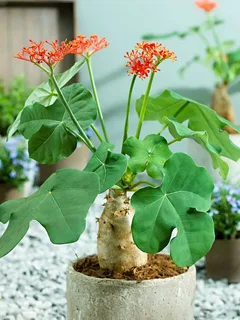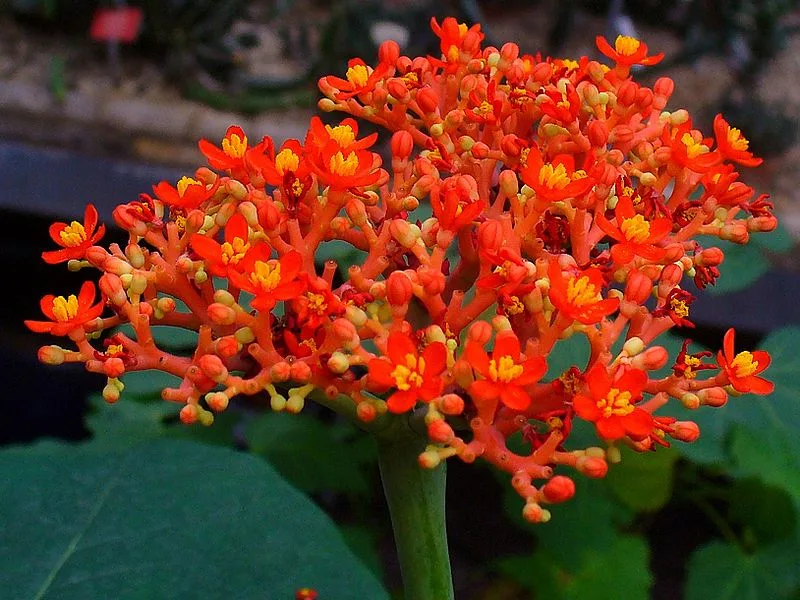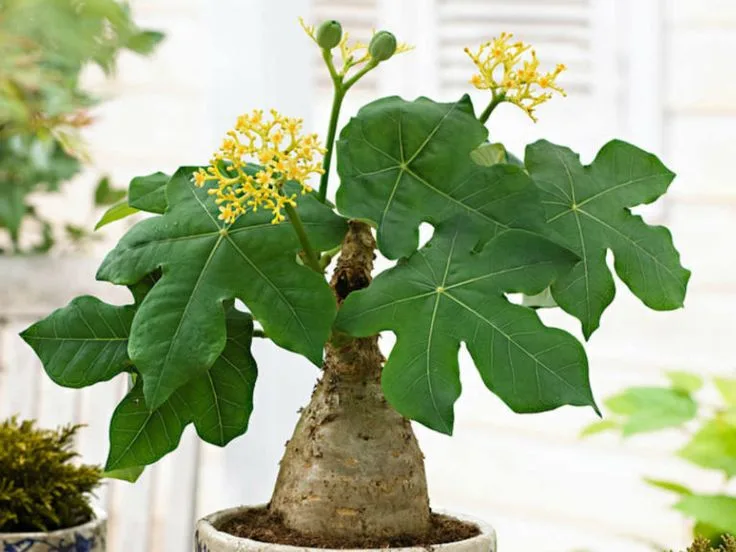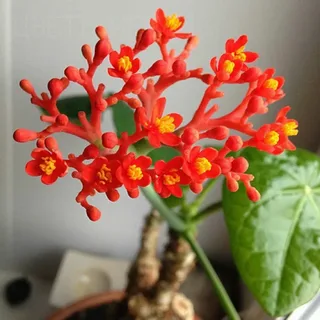Table of Contents
Introduction
Jatropha podagrica, also known as “coral plant” or “devil’s finger”, is an exotic succulent native to Central America and Mexico. This unique plant attracts attention with its succulent, swollen stems, which resemble fingers or tentacles. Its bright green leaves and red or orange flowers complete its intriguing appearance. Jatropha podagrica is an excellent choice for succulent gardens or collections, adding a touch of exoticism and uniqueness to the environment.
Meaning of Jatropha podagrica
In addition to its unusual beauty, Jatropha pod agrica has symbolic meanings. In popular culture, it is associated with protection, vitality and renewal. Its succulent and resistant stems are seen as symbols of strength and adaptation, while its vibrant flowers represent the energy and vitality of life. Having a Jatropha podagrica at home can be considered a good luck charm and a source of inspiration for facing challenges with determination and vigor.
| Item | Information |
|---|---|
| Common Name | Coral Plant, Devil’s Finger |
| Botanical Name | Jatropha podagrica |
| Family | Euphorbiaceae |
| Plant Type | Succulent shrub |
| Size Adult | 1 to 2 meters high |
| Sun exposure | Full sun or half shade |
| Soil type | Well-drained, sandy |
| soil pH | Neutral to slightly acidic (6.0 – 7.0) |
| Flowering time | Spring and summer |
| Flower color | Red or orange |
| Native Area | Central America, Mexico |
| Toxicity | Toxic, may cause irritation to skin and mucous membranes |

How to care for Jatropha podagrica
Discover the essential care to keep your Jatropha podagrica healthy and lush.
Light
Jatropha pod agrica prefers places with full sun or half shade. Make sure you place it in a spot where it receives direct sunlight for a few hours of the day, especially during the morning or afternoon hours.
Soil
This plant thrives in well-drained, sandy soil. Make sure the soil has a good drainage capacity to avoid water accumulating around the roots, which can lead to rotting.
Watering
Water your Jatropha podagrica moderately, allowing the soil to dry out between waterings. Avoid soaking the soil, as this can cause damage to the roots. During the warmer months, it may be necessary to increase the frequency of watering.
Temperature and humidity
This plant prefers moderate temperatures and does not tolerate frost. Keep your Jatropha podagrica in a room with a temperature between 15°C and 30°C. As for humidity, it tolerates moderate levels, but avoid excessively humid environments to prevent problems such as powdery mildew.
Fertilizing
Fertilize your Jatropha podagrica during spring and summer with a balanced fertilizer for succulent plants. Follow the manufacturer’s instructions and avoid over-fertilizing, as this can cause salts to build up in the soil.

How to make Jatropha podagrica cuttings
Here are the simple steps to propagate your Jatropha podagrica through cuttings:
How to Make Cuttings:
- Stem selection: Choose healthy, vigorous stems from the mother plant to make your cuttings. Choose stems that show no damage or signs of disease.
- Cutting the stems: With clean, sharp scissors, make clean cuts in the selected stems, about 10 to 15 centimeters long. Make sure that each cut has at least two knots.
- Drying the stems: Leave the cut stems to dry outdoors for a few days in a cool, shaded place. This allows the cut ends to heal and reduces the risk of infection.
- Planting the seedlings: After drying, plant the seedlings in a light, well-drained substrate. Bury the stems in the soil, leaving only the nodes exposed. Keep the soil slightly moist until the seedlings develop roots.
How to plant Jatropha podagrica
Preparing the soil:
- Site selection: Choose a spot in full sun or half shade to plant your Jatropha podagrica seedlings. Make sure the soil is well-drained and sandy.
- Soil preparation: Prepare the soil by removing debris and weeds. If necessary, add sand or perlite to improve the drainage and aeration of the soil.
Planting the seedlings:
- Transplanting the cuttings: When transplanting the rooted cuttings, dig small holes in the soil and plant the cuttings, gently pressing the soil around them. Make sure you leave enough space between the cuttings to allow for future growth.
- Initial watering: After planting, water the seedlings carefully to help establish the roots. Avoid over-watering, as the seedlings are still adapting to their new environment.
- Aftercare: Continue to monitor your Jatropha podagrica seedlings, watering as necessary and providing adequate light. Over time, your seedlings will grow into mature, healthy plants.

Most common pests and diseases
Discover the pests and diseases that can affect your Jatropha podagrica:
- Mealybugs: Insects that feed on the sap of the plant, leaving behind a sticky substance called honeydew.
- Aphids: Small insects that feed on the tissues of the leaves, causing deformations and curling of the leaves.
- Powdery mildew: A fungus that manifests itself as a powdery white coating on the leaves and stems of the plant.
- Root rot: Caused by excess moisture in the soil, which can lead to root rot.
- Wilt: Caused by soil fungi, resulting in wilting and death of the affected parts of the plant.
Common Problems and Their Solutions
Here are some solutions to the most common problems faced by Jatropha podagrica:
Mealybugs and Aphids:
- Solution: Remove the mealybugs and aphids by hand with a damp cloth or spray with soapy water. If necessary, apply an insecticide specifically for mealybugs and aphids.
Powdery mildew:
- Solution: Remove the affected parts of the plant and apply a specific fungicide for powdery mildew. Make sure to improve air circulation around the plant to avoid favorable conditions for the fungus.
Root rot:
- Solution: Reduce the frequency of watering and make sure the soil has good drainage. Remove the affected parts of the plant and replant in new soil if necessary.
Wilt:
- Solution: Discard infected plants to avoid spreading the disease. Make sure you plant in well-drained soil and avoid excess moisture. Use crop rotation to avoid re-infecting the soil.

Curiosities and myths
Discover interesting facts and dispel the myths surrounding Jatropha podagrica:
Curiosities:
- Exotic Origin: Jatropha podagrica, also known as “coral plant” or “devil’s finger”, is native to Central America and Mexico, where it grows in arid, sunny soils.
- Unique Shape: Its succulent, swollen stems resemble fingers or tentacles, giving it an intriguing and distinctive appearance.
- Vibrant flowers: During the flowering season, Jatropha podagrica produces small red or orange flowers, adding a touch of color to its exotic look.
Myths:
- Protection and Luck: In popular culture, it is believed that having a Jatropha podagrica in the house brings protection against negative energies and bad luck, serving as an amulet of protection and good fortune.
- Healing Power: Some myths suggest that the latex produced by the plant has healing properties and is traditionally used to treat a variety of health conditions, such as joint pain and skin problems.
- Mystical Resistance: There are reports that Jatropha podagrica is an extremely resistant plant, capable of surviving in adverse conditions and even thriving in poor soils and arid environments.

Conclusion
To sum up, Jatropha pod agrica is much more than just an ornamental plant – it’s a fascinating combination of beauty, mystery and symbolism. Originally from Central America and Mexico, its peculiar shape and vibrant flowers make it a unique addition to any garden or collection of succulent plants. What’s more, the myths and legends surrounding it, such as its power of protection and luck, add an extra layer of fascination to its presence.
Growing a Jatropha podagrica not only brings an exotic touch to the environment, but also invites reflection on the deeper meanings it represents. Whether as an amulet of protection or a source of inspiration, this plant continues to captivate and enchant those who have the pleasure of growing it.
Frequently Asked Questions
What is Jatropha Multifida used for?
The Jatropha Multifida plant is known for its medicinal and ornamental properties. Its leaves are used in traditional medicine to treat a variety of conditions, while its exotic beauty makes it a popular choice for ornamental gardens.
How to grow Jatropha Podagrica?
Growing Jatropha Podagrica requires specific care. It is important to provide it with direct or indirect sunlight, well-drained soil and moderate watering. It should also be protected from frost and extreme temperatures. With proper care, it will flourish and thrive in your garden.
What is the jatropha plant used for?
The jatropha plant is known for its seed oil, which can be used in the production of biodiesel. In addition, some varieties have medicinal properties and are used in traditional medicine to treat various conditions, such as headaches and rheumatism.







